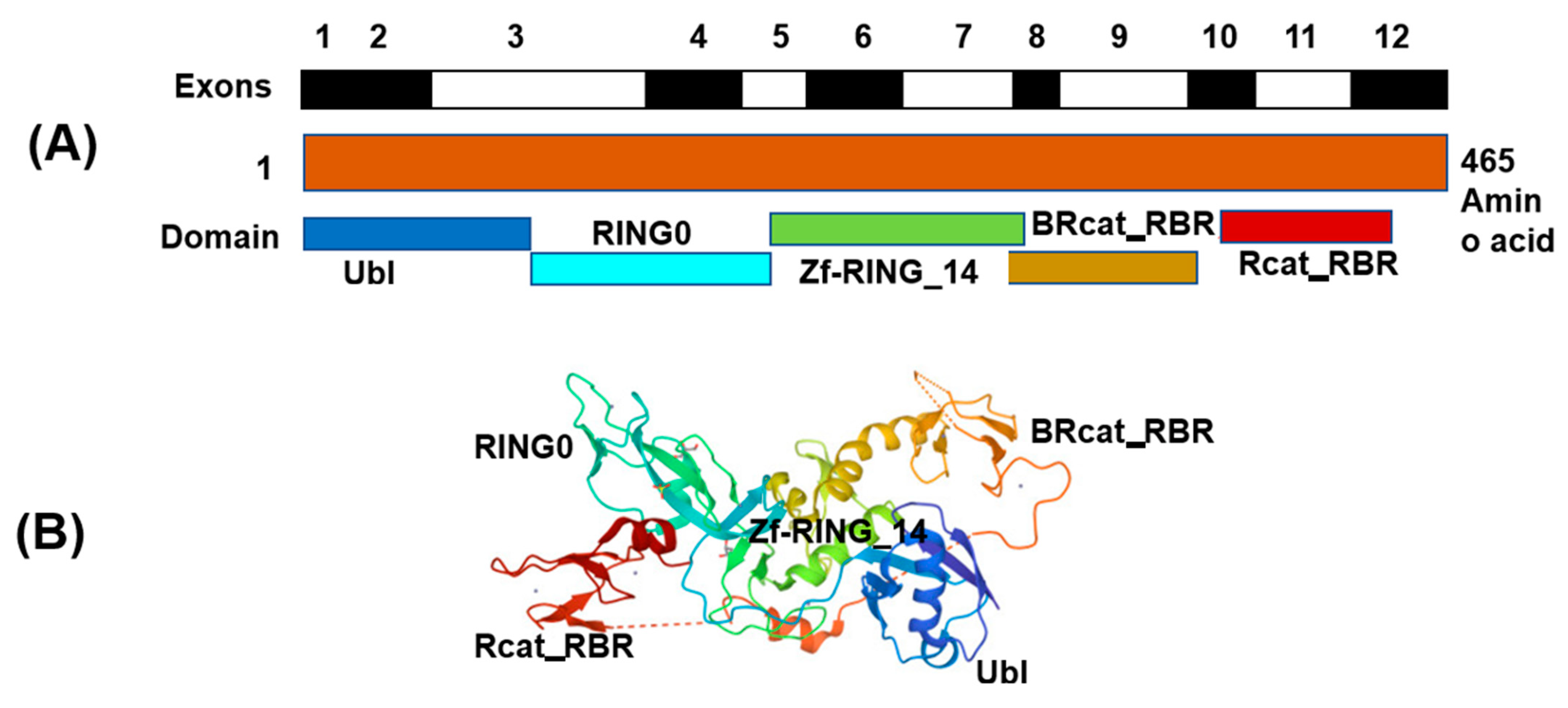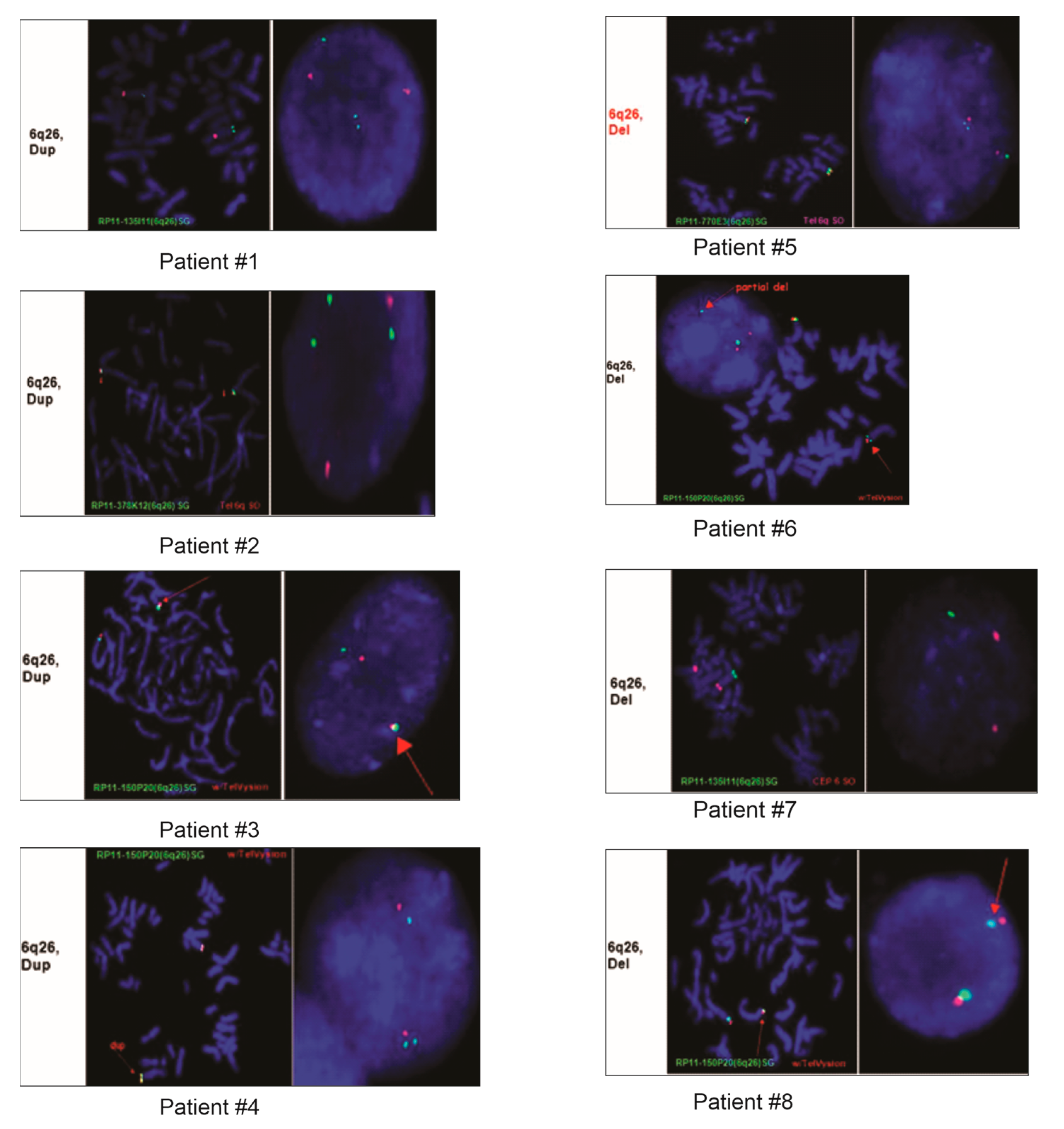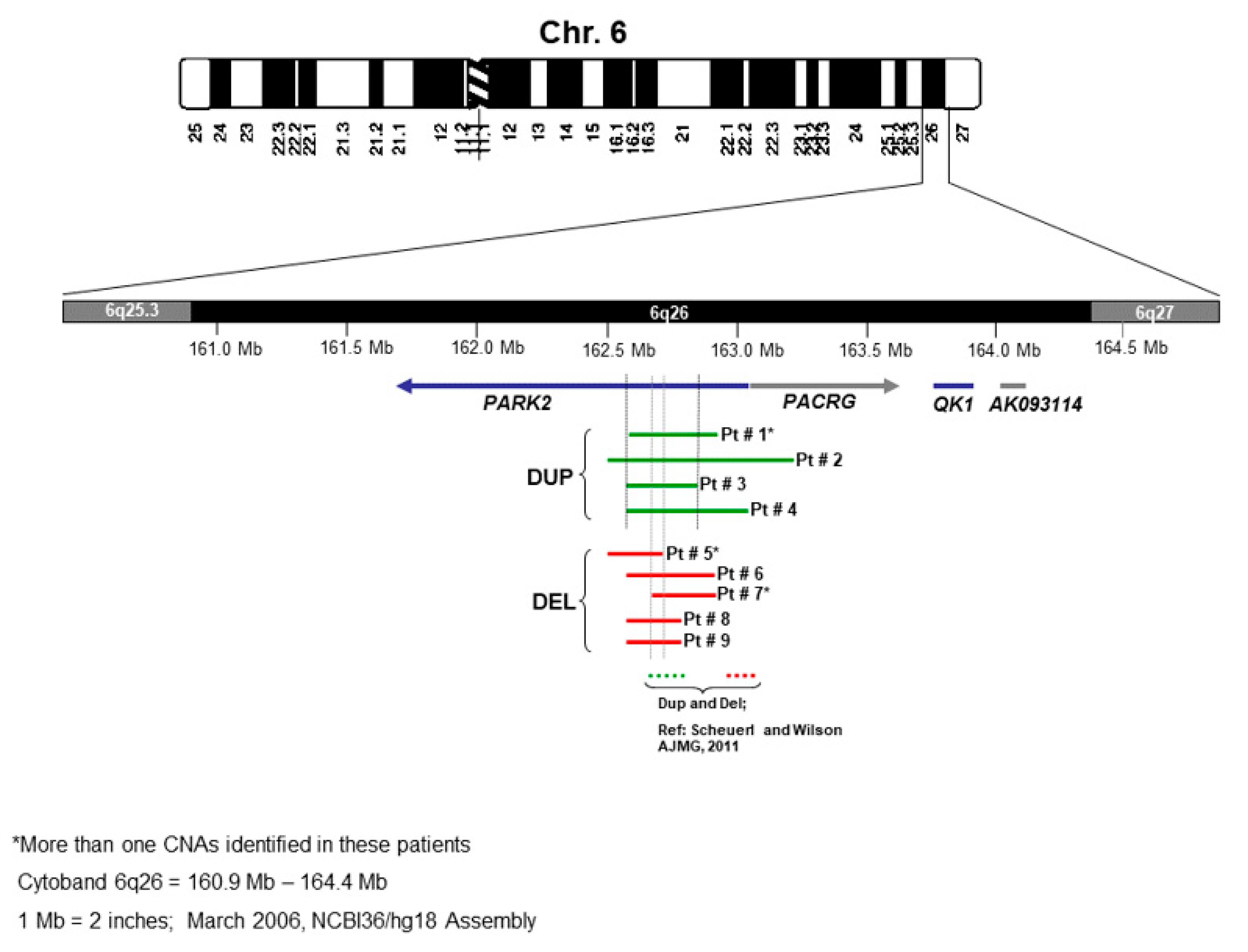PARK2 Microdeletion or Duplications Have Been Implicated in Different Neurological Disorders Including Early Onset Parkinson Disease
Abstract
:1. Introduction
2. Materials and Methods
2.1. Clinical Specimens
2.2. aCGH Analysis
2.3. FISH Analysis
3. Results
4. Discussion
Author Contributions
Funding
Institutional Review Board Statement
Informed Consent Statement
Data Availability Statement
Conflicts of Interest
References
- da Costa, C.A.; Sunyach, C.; Giaime, E.; West, A.; Corti, O.; Brice, A.; Safe, S.; Abou-Sleiman, P.M.; Wood, N.W.; Takahashi, H.; et al. Transcriptional repression of p53 by parkin and impairment by mutations associated with autosomal recessive juvenile Parkinson’s disease. Nat. Cell Biol. 2009, 11, 1370–1375. [Google Scholar] [CrossRef] [PubMed]
- Kitada, T.; Asakawa, S.; Hattori, N.; Matsumine, H.; Yamamura, Y.; Minoshima, S.; Yokochi, M.; Mizuno, Y.; Shimizu, N. Mutations in the parkin gene cause autosomal recessive juvenile parkinsonism. Nature 1998, 392, 605–608. [Google Scholar] [CrossRef] [PubMed]
- Konovalova, E.V.; Lopacheva, O.M.; Grivennikov, I.A.; Lebedeva, O.S.; Dashinimaev, E.B.; Khaspekov, L.G.; Fedotova, E.Y.; Illarioshkin, S.N. Mutations in the Parkinson’s Disease-Associated PARK2 Gene Are Accompanied by Imbalance in Programmed Cell Death Systems. Acta Nat. 2015, 7, 146–149. [Google Scholar] [CrossRef]
- Huynh, D.P.; Scoles, D.R.; Ho, T.H.; Del Bigio, M.R.; Pulst, S.-M. Parkin is associated with actin filaments in neuronal and nonneural cells. Ann. Neurol. 2000, 48, 737–744. [Google Scholar] [CrossRef] [PubMed]
- Hedrich, K.; Kann, M.; Lanthaler, A.J.; Dalski, A.; Eskelson, C.; Landt, O.; Schwinger, E.; Vieregge, P.; Lang, A.E.; Breakefield, X.O.; et al. The importance of gene dosage studies: Mutational analysis of the parkin gene in early-onset parkinsonism. Hum. Mol. Genet. 2001, 10, 1649–1656. [Google Scholar] [CrossRef]
- Glessner, J.T.; Wang, K.; Cai, G.; Korvatska, O.; Kim, C.E.; Wood, S.; Zhang, H.; Estes, A.; Brune, C.W.; Bradfield, J.P.; et al. Autism genome-wide copy number variation reveals ubiquitin and neuronal genes. Nature 2009, 459, 569–573. [Google Scholar] [CrossRef]
- Scheuerle, A.; Wilson, K. PARK2 copy number aberrations in two children presenting with autism spectrum disorder: Further support of an association and possible evidence for a new microdeletion/microduplication syndrome. Am. J. Med. Genet. Part B Neuropsychiatr. Genet. 2011, 156, 413–420. [Google Scholar] [CrossRef]
- Xu, L.; Lin, D.-C.; Yin, D.; Koeffler, H.P. An emerging role of PARK2 in cancer. J. Mol. Med. 2014, 92, 31–42. [Google Scholar] [CrossRef]
- Sun, X.; Liu, M.; Hao, J.; Li, D.; Luo, Y.; Wang, X.; Yang, Y.; Li, F.; Shui, W.; Chen, Q.; et al. Parkin deficiency contributes to pancreatic tumorigenesis by inducing spindle multipolarity and misorientation. Cell Cycle 2013, 12, 1133–1141. [Google Scholar] [CrossRef]
- Yin, C.-L.; Chen, H.-I.; Li, L.-H.; Chien, Y.-L.; Liao, H.-M.; Chou, M.C.; Chou, W.-J.; Tsai, W.-C.; Chiu, Y.-N.; Wu, Y.-Y.; et al. Genome-wide analysis of copy number variations identifies PARK2 as a candidate gene for autism spectrum disorder. Mol. Autism 2016, 7, 23. [Google Scholar] [CrossRef]
- Jarick, I.; Volckmar, A.L.; Pütter, C.; Pechlivanis, S.; Nguyen, T.T.; Dauvermann, M.R.; Beck, S.; Albayrak, Ö.; Scherag, S.; Gilsbach, S.; et al. Genome-wide analysis of rare copy number variations reveals PARK2 as a candidate gene for attention-deficit/hyperactivity disorder. Mol. Psychiatry 2014, 19, 115–121. [Google Scholar] [CrossRef] [PubMed]
- Weiss, L.A.; Arking, D.E.; The Gene Discovery Project of Johns Hopkins & the Autism Consortium; Daly, M.J.; Chakravarti, A. A genome-wide linkage and association scan reveals novel loci for autism. Nature 2009, 461, 802–808. [Google Scholar] [CrossRef] [PubMed]
- Bacchelli, E.; Cameli, C.; Viggiano, M.; Igliozzi, R.; Mancini, A.; Tancredi, R.; Battaglia, A.; Maestrini, E. An integrated analysis of rare CNV and exome variation in Autism Spectrum Disorder using the Infinium PsychArray. Sci. Rep. 2020, 10, 3198. [Google Scholar] [CrossRef] [PubMed]
- Mariani, M.; Crosti, F.; Redaelli, S.; Fossati, C.; Piras, R.; Biondi, A.; Dalprà, L.; Selicorni, A. Partial duplication of the PARK2 gene in a child with developmental delay and her normal mother: A second report. Am. J. Med. Genet. Part B Neuropsychiatr. Genet. 2013, 162, 485–486. [Google Scholar] [CrossRef]
- Kay, D.M.; Stevens, C.F.; Hamza, T.H.; Montimurro, J.S.; Zabetian, C.P.; Factor, S.A.; Samii, A.; Griffith, A.; Roberts, J.W.; Molho, E.S.; et al. A comprehensive analysis of deletions, multiplications, and copy number variations in PARK2. Neurology 2010, 75, 1189–1194. [Google Scholar] [CrossRef]
- Mascarello, J.T.; Hirsch, B.; Kearney, H.M.; Ketterling, R.P.; Olson, S.B.; Quigley, D.I.; Rao, K.W.; Tepperberg, J.H.; Tsuchiya, K.D.; Wiktor, A.E.; et al. Section E9 of the American College of Medical Genetics technical standards and guidelines: Fluorescence in situ hybridization. Genet. Med. 2011, 13, 667–675. [Google Scholar] [CrossRef]
- Palumbo, O.; Palumbo, P.; Leone, M.P.; Stallone, R.; Palladino, T.; Vendemiale, M.; Palladino, S.; Papadia, F.; Carella, M.; Fischetto, R. PARK2 Microduplication: Clinical and Molecular Characterization of a Further Case and Review of the Literature. Mol. Syndr. 2016, 7, 282–286. [Google Scholar] [CrossRef]
- Lücking, C.B.; Dürr, A.; Bonifati, V.; Vaughan, J.; De Michele, G.; Gasser, T.; Harhangi, B.S.; Meco, G.; Denèfle, P.; Wood, N.W.; et al. Association between Early-Onset Parkinson’s Disease and Mutations in the Parkin Gene. N. Engl. J. Med. 2000, 342, 1560–1567. [Google Scholar] [CrossRef]
- Wauer, T.; Komander, D. Structure of the human Parkin ligase domain in an autoinhibited state. Embo. J. 2013, 32, 2099–2112. [Google Scholar] [CrossRef]
- Conceição, I.C.; Rama, M.M.; Oliveira, B.; Café, C.; Almeida, J.; Mouga, S.; Duque, F.; Oliveira, G.; Vicente, A.M. Definition of a putative pathological region in PARK2 associated with autism spectrum disorder through in silico analysis of its functional structure. Psychiatr. Genet. 2017, 27, 54–61. [Google Scholar] [CrossRef]
- Natacci, F.; Alfei, E.; Tararà, L.; D’Arrigo, S.; Zuffardi, O.; Gentilin, B.; Pantaleoni, C. Chromosome 17q21.31 duplication syndrome: Description of a new familiar case and further delineation of the clinical spectrum. Eur. J. Paediatr. Neurol. 2016, 20, 183–187. [Google Scholar] [CrossRef] [PubMed]
- Grisart, B.; Willatt, L.; Destrée, A.; Fryns, J.P.; Rack, K.; de Ravel, T.; Rosenfeld, J.; Vermeesch, J.R.; Verellen-Dumoulin, C.; Sandford, R. 17q21.31 microduplication patients are characterised by behavioural problems and poor social interaction. J. Med. Genet. 2009, 46, 524. [Google Scholar] [CrossRef] [PubMed]
- Berg, J.S.; Potocki, L.; Bacino, C.A. Common recurrent microduplication syndromes: Diagnosis and management in clinical practice. Am. J. Med. Genet. Part A 2010, 152A, 1066–1078. [Google Scholar] [CrossRef] [PubMed]



| Patient ID | BAC Probe (Test) | Control Probe |
|---|---|---|
| Pt. # 1 | RP11-135I11, Spectrum Green (6q26) and RP11-609G9, Spectrum Green (17q21.31–q21.32) | TelVysion 6q, Spectrum Orange TelVysion 17p, Spectrum Orange |
| Pt. # 2 | RP11-378K12, Spectrum Green | TelVysion 6q, Spectrum Orange |
| Pt. # 3 | RP11-150P20, Spectrum Green | W/TelVysion, Spectrum Orange |
| Pt. # 4 | RP11-150P20, Spectrum Green | W/TelVysion, Spectrum Orange |
| Pt. # 5 | RP11-770E3, Spectrum Green(6q26) and TelVysion 20p/20q, Spectrum Green (20p13) | TelVysion 6q, Spectrum Orange and TelVysion 20q, Spectrum Orange |
| Pt. # 6 | RP11-135I11 | |
| Pt. # 7 | RP11-135I11, Spectrum Green (6q26); RP11-64O16, Spectrum Green (7q35); RP11-818O24, Spectrum Orange (17p13.3); and RP11-48K6, Spectrum Orange (19p12) | CEP 6, Spectrum Orange; TelVysion 7q, Spectrum Orange; TelVysion 17p, Spectrum Green; and TelVysion 19p, Spectrum Green |
| Pt. # 8 | RP11-150P20, Spectrum Green | W/TelVysion, Spectrum Orange |
| Pt. # 9 | RP11-150P20, Spectrum Green | W/TelVysion, Spectrum Orange |
| Clinical Features/Patient | 1 | 2 | 3 | 4 | 5 | 6 | 7 | 8 | 9 |
|---|---|---|---|---|---|---|---|---|---|
| PARK2 status | Duplication | Deletion | |||||||
| Developmental delay | Yes | Yes | Yes | Yes | Yes | ||||
| Seizures | Yes | Yes | |||||||
| Dysmorphic features | Yes | Yes | |||||||
| Hypotonia | Yes | Yes | |||||||
| Congenital anomalies | Yes | Yes | Yes | ||||||
| Autism spectrum disorder | Yes | ||||||||
| ADHD | Yes | ||||||||
| Encephalopathy | Yes | ||||||||
| Size of deletion or duplication | 347 Kb | 726 Kb | 279 Kb | 476 Kb | 215 Kb | 346 Kb | 252 kb | 216 Kb | 216 Kb |
| Case | Age | Sex | Cytoband | Coordinates | Size | Del/Dup | Exons Involved | Origin | Known Genes |
|---|---|---|---|---|---|---|---|---|---|
| Pt # 1 | 9 Y | F | 6q26 and 17q21.31–q21.32 | 162573881_16292045141544024_42049740 | 347 kb 506 kb | Dup Dup | 7–9 | Father | 6q26 = PARK2 17q21.31–q21.32 = NSF, ARL17P1, LRRC37A, KIAA1267, LOC644246, LOC51326 |
| Pt # 2 | 1 Y | M | 6q26 | 162504320_163230798 | 726 kb | Dup | 7–12 | Mother | PARK2 and PACRG |
| Pt # 3 | 33 Y 7 M | F | 6q26 | 162574111_162853117 | 279 kb | Dup | 7–8 | NA | PARK2 |
| Pt # 4 | 28 Y 9 M | F | 6q26 | 162574111_163049684 | 476 kb | Dup | 7–10 | NA | PARK2 |
| Pt # 5 | 5 Y 3 M | F | 6q26 and 20p13 | 162504090_162719512 18380_138265 | 215 kb 120 kb | Del Dup | 7 | de novo | 6q26 = PARK2 20p13 = DEFB125, DEFB126, DEFB127, and DEFB128 |
| Pt # 6 | 9 Y 3 M | M | 6q26 | 162574111_162920281 | 346 kb | Del | 7–9 | NA | PARK2 |
| Pt # 7 | 2 Y 6 M | M | 6q26; 7q35; 17p13.3; and 19p12 | 162668308_162920281 145998312_146189705 915669_2952347 23604133_23924885 | 252kb 191 kb 2.04 Mb 321 kb | Del Del Dup Dup | 8–9 | NA | 6q26 = PARK2 7q35 = CNTNAP2 17p13.3 = PAFAH1B1, MDLS, PRPF8, PEDF 19p12 = RPSA, ZNF681, ZNF675, AK125686, BC015383, LOC370087, BC082233 |
| Pt # 8 | 2 M | F | 6q26 | 162574111_162790389 | 216 kb | Del | 7 | Father | PARK2 |
| Pt # 9 | 39 Y 2 M | M | 6q26 | 162574111_162790389 | 216 kb | Del | 7 | NA | PARK2 |
Disclaimer/Publisher’s Note: The statements, opinions and data contained in all publications are solely those of the individual author(s) and contributor(s) and not of MDPI and/or the editor(s). MDPI and/or the editor(s) disclaim responsibility for any injury to people or property resulting from any ideas, methods, instructions or products referred to in the content. |
© 2023 by the authors. Licensee MDPI, Basel, Switzerland. This article is an open access article distributed under the terms and conditions of the Creative Commons Attribution (CC BY) license (https://creativecommons.org/licenses/by/4.0/).
Share and Cite
Ahmad, A.; Nkosi, D.; Iqbal, M.A. PARK2 Microdeletion or Duplications Have Been Implicated in Different Neurological Disorders Including Early Onset Parkinson Disease. Genes 2023, 14, 600. https://doi.org/10.3390/genes14030600
Ahmad A, Nkosi D, Iqbal MA. PARK2 Microdeletion or Duplications Have Been Implicated in Different Neurological Disorders Including Early Onset Parkinson Disease. Genes. 2023; 14(3):600. https://doi.org/10.3390/genes14030600
Chicago/Turabian StyleAhmad, Ausaf, Dingani Nkosi, and Mohammed A. Iqbal. 2023. "PARK2 Microdeletion or Duplications Have Been Implicated in Different Neurological Disorders Including Early Onset Parkinson Disease" Genes 14, no. 3: 600. https://doi.org/10.3390/genes14030600





